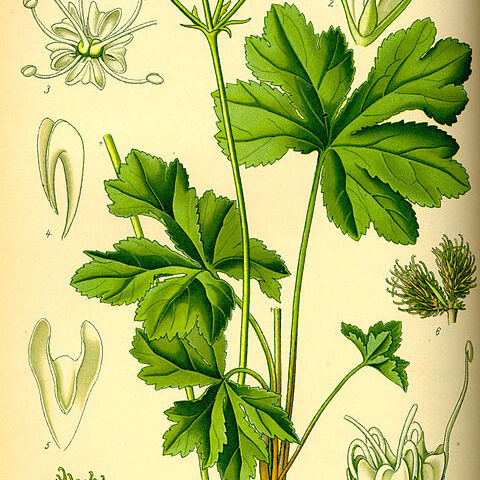Perennial or more rarely biennial herbs. Leaves ternate, palmatipartite or pinnate, rarely undivided. Umbels simple, sometimes arranged to appear as if compound, in a dichasially branched cyme or more rarely racemosely arranged; involucre presentCalyx-teeth conspicuous, free to ± connate. Flowers polygamous, the outer few–many ♂, the inner (generally few) hermaphrodite, occasionally some umbels entirely ♂. Petals white to yellowish, pink tinged or bluish, emarginate above with an incurved lobule. Fruit globose to oblong-ovoid, not compressed, covered with prickles, scales or tubercles, the prickles often expanded below, straight or uncinate, sometimes connate at the base; mericarps not to distinctly narrowed to the commissure; primary ribs obsolete; vittae on the dorsal surface 3–many, on the commissural face usually 2; stylopodia flattened, concave or obscure; carpophore none. Endosperm rounded dorsally, flattened to ± excavate on the commissural face.
Fr ovoid or oblong to subglobose, slightly flattened laterally, not readily separating into mericarps, densely covered with hooked bristles sometimes arranged in rows; ribs obsolete; oil-tubes in our spp. (except no. 5) solitary in the intervals, 2–3 on the commissure; umbel irregular, with unequal spreading primary branches, the umbellets dense or subcapitate, commonly with 3 sessile or short-pedicellate perfect fls, their ovary bristly, and several staminate fls with smooth ovary, these all or chiefly on much longer pedicels; sep relatively well developed, narrow, connate at base, persistent; pet greenish-white to greenish-yellow; stylopodium wanting; stems in our spp. arising from a cluster of fibrous or fleshy-fibrous roots; lvs palmately divided into 3–5(–7) broad segments, the basal long-petioled, the cauline progressively reduced and less petiolate; invol foliaceous. 40, nearly cosmop.
Perennial or biennial, glabrous, or pubescent herbs from taproots, rootstocks, tubers, or fascicled roots; stems (sometimes obsolete) erect to rarely decumbent, simple or branched, the leaves petiolate, lobed or divided to decompound, rarely entire, the petiole sheathing; inflorescence of cymosely, umbellately, or panicu-lately arranged small heads subtended by a foliaceous involucre, the flowers perfect and staminate, white, yellow, or purple, the petals with an inflexed apex, the calyx very prominent and persistent; stylopodium lacking, the styles short to elongate, a carpophore lacking; fruit somewhat compressed laterally and densely tuberculate, scaly, or bristly, sessile or stipitate, the ribs obsolete, the vittae irregularly arranged, prominent to obscure; seed subterete or flattened dorsally, often sulcate beneath the vittae, its face flat to concave or sulcate.
Erect herbs; leaves palmately 3-5-partite, segments dentate, lobed or pinnately dissected. Flowers in irregular compound umbels with few rays; involucres leaflike; umbellules usually small, with small involucels. Calyx teeth subherbaceous or membranaceous. Petals white, emarginate with inflexed tip, slightly imbricate. Disk flat with raised margin encircling the styles. Styles from the base filiform or subincrassate. Fruits echinate, ovoid, subterete or laterally subflattened; commissure broad; mericarps with obscure ribs, lateral ones in the commissure, inner surface flat; vittae slender, solitary in each ridge, some very slender scattered in the endosperm.
Partial umbels with hermaphrodite and male flowers, the hermaphrodite one frequently distinctly pedicellate, the male ones sessile to subsessile.
Leaves petiolate, subsessile, usually somewhat coriaceous, palmately to pinnately divided; petioles with sheathing bases.
Inflorescence of rather irregular compound umbels with few, unequal rays.
Vittae both large and small, regularly or irregularly arranged.
Fruit ovoid, densely covered with prickles or tubercles.
Erect, rarely decumbent herbs, biennial or perennial.
Stem usually branched in a pseudodichotomous manner.
Seed plane or concave on the commissural face.
Styles short or long and spreading.
Stylopodium depressed or obsolete.

